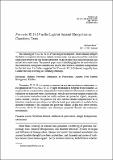Por favor, use este identificador para citar o enlazar a este item:
http://hdl.handle.net/10261/20729COMPARTIR / EXPORTAR:
 SHARE
BASE SHARE
BASE
|
|
| Visualizar otros formatos: MARC | Dublin Core | RDF | ORE | MODS | METS | DIDL | DATACITE | |

| Campo DC | Valor | Lengua/Idioma |
|---|---|---|
| dc.contributor.author | Böck, Barbara | - |
| dc.date.accessioned | 2010-02-05T09:30:16Z | - |
| dc.date.available | 2010-02-05T09:30:16Z | - |
| dc.date.issued | 2009-12-30 | - |
| dc.identifier.citation | Sefarad 69(2): 263-279 (2009) | en_US |
| dc.identifier.issn | 0037-0894 | - |
| dc.identifier.uri | http://hdl.handle.net/10261/20729 | - |
| dc.description | 18 pages. | en_US |
| dc.description.abstract | [EN] The meaning of Proverbs 30:18-19 has long been disputed. Most scholars interpret the Biblical couplets textually on stylistic features only; an explanation of the contextual association between the four motifs mentioned (eagle, serpent, boat, man and woman) has not yet been undertaken. The present paper aims at shedding light on the motivation for this association, taking into consideration ancient Near Eastern cuneiform compositions for the first time. It is further suggested that Proverbs 30:18-19 derived originally from a riddle that had its setting in a wedding ceremony. | en_US |
| dc.description.abstract | [ES] El significado de Proverbios 30:18-19 sigue desafiando la exégesis de los biblistas. La mayoría de los comentaristas interpretan los versos bíblicos textualmente, ciñéndose al análisis de las figuras de estilo. Sin embargo, todavía no se ha dado ninguna explicación a la asociación contextual entre los cuatro motivos del proverbio (águila, serpiente, barco, hombre y mujer). Por primera vez, este artículo estudia composiciones de la literatura cuneiforme que ofrecen un telón de fondo para interpretar el sentido de los distintos elementos y del conjunto del proverbio bíblico. Según esta nueva lectura, Proverbios 30:18-19 describiría una adivinanza propuesta durante una ceremonia matrimonial. | en_US |
| dc.format.extent | 371618 bytes | - |
| dc.format.mimetype | application/pdf | - |
| dc.language.iso | eng | en_US |
| dc.publisher | Consejo Superior de Investigaciones Científicas (España) | en_US |
| dc.rights | openAccess | en_US |
| dc.subject | Biblical proverbs | en_US |
| dc.subject | Metaphors of procreation | en_US |
| dc.subject | Ancient near eastern Ancient near eastern background | en_US |
| dc.subject | Riddles | en_US |
| dc.subject | Proverbios bíblicos | en_US |
| dc.subject | Metáforas de procreación | en_US |
| dc.subject | Mesopotamia antigua | en_US |
| dc.subject | Adivinanzas | en_US |
| dc.title | Proverbs 30:18-19 in the light of ancient mesopotamian cuneiform texts | en_US |
| dc.title.alternative | Proverbios 30:18-19 a la luz de los antiguos textos mesopotámicos cuneiformes | en_US |
| dc.type | artículo | en_US |
| dc.description.peerreviewed | Peer reviewed | en_US |
| dc.relation.publisherversion | http://sefarad.revistas.csic.es/index.php/sefarad/article/view/595 | en_US |
| dc.identifier.e-issn | 1988-320X | - |
| dc.type.coar | http://purl.org/coar/resource_type/c_6501 | es_ES |
| item.cerifentitytype | Publications | - |
| item.openairecristype | http://purl.org/coar/resource_type/c_18cf | - |
| item.grantfulltext | open | - |
| item.openairetype | artículo | - |
| item.fulltext | With Fulltext | - |
| item.languageiso639-1 | en | - |
| Aparece en las colecciones: | (CCHS-ILC) Artículos | |
Ficheros en este ítem:
| Fichero | Descripción | Tamaño | Formato | |
|---|---|---|---|---|
| 694.pdf | 362,91 kB | Adobe PDF |  Visualizar/Abrir |
CORE Recommender
Page view(s)
479
checked on 05-may-2024
Download(s)
1.834
checked on 05-may-2024
Google ScholarTM
Check
NOTA: Los ítems de Digital.CSIC están protegidos por copyright, con todos los derechos reservados, a menos que se indique lo contrario.
